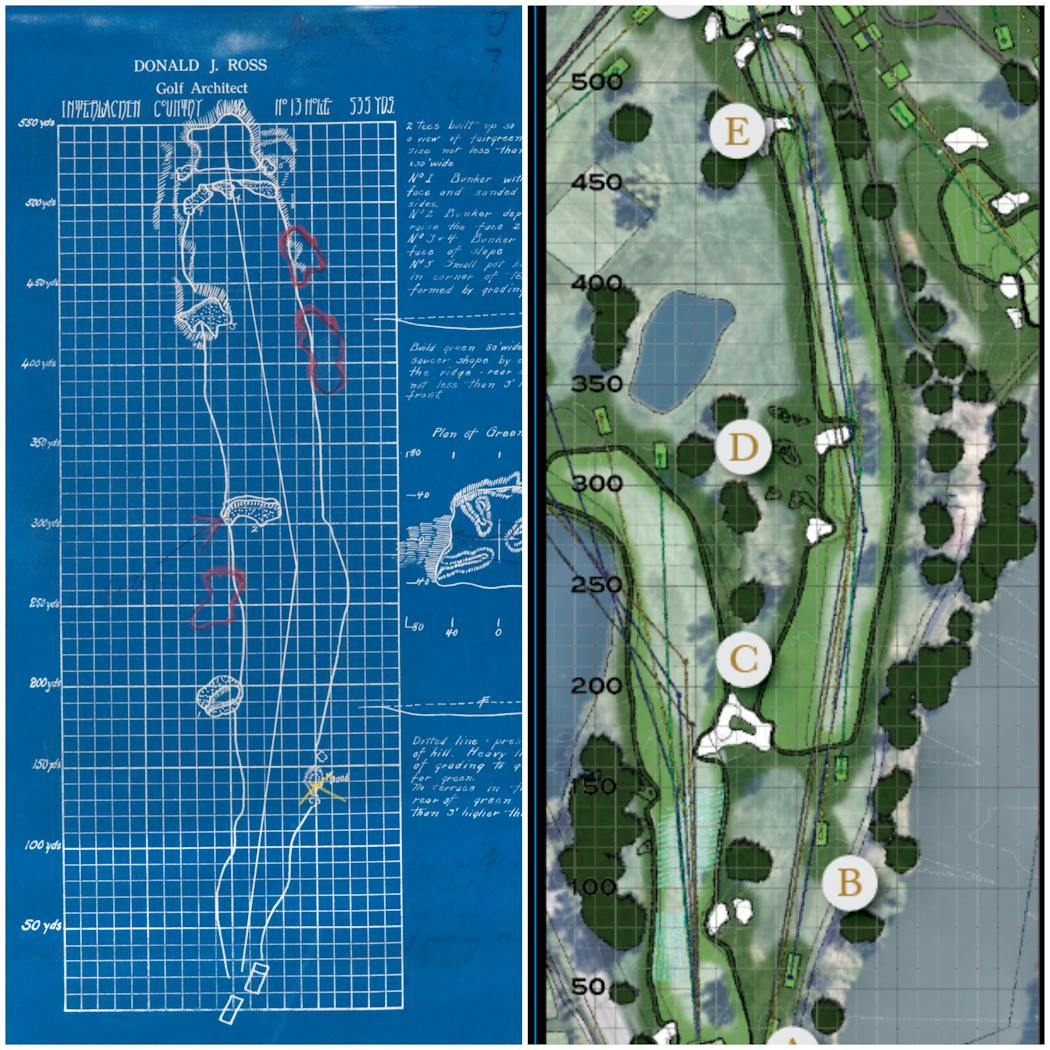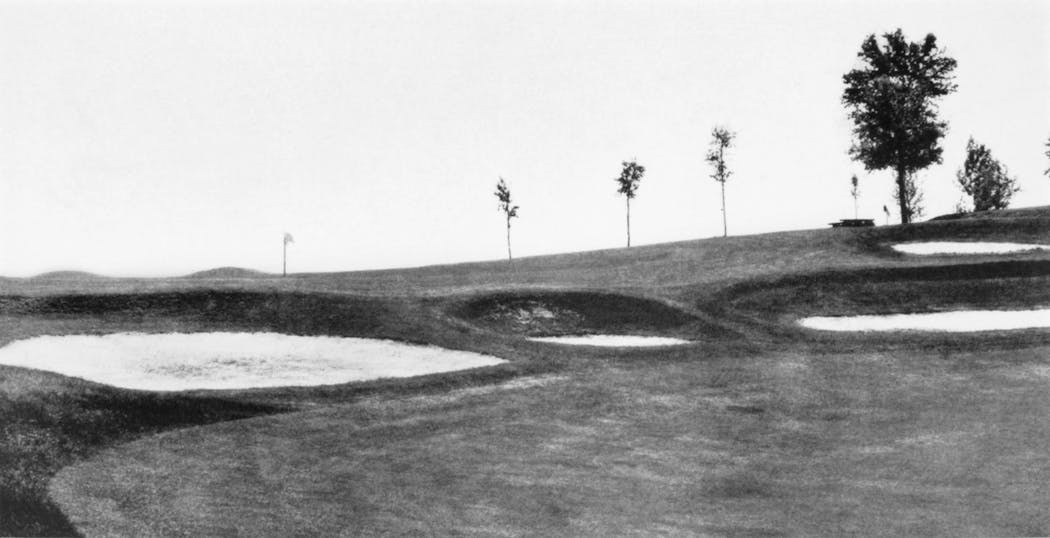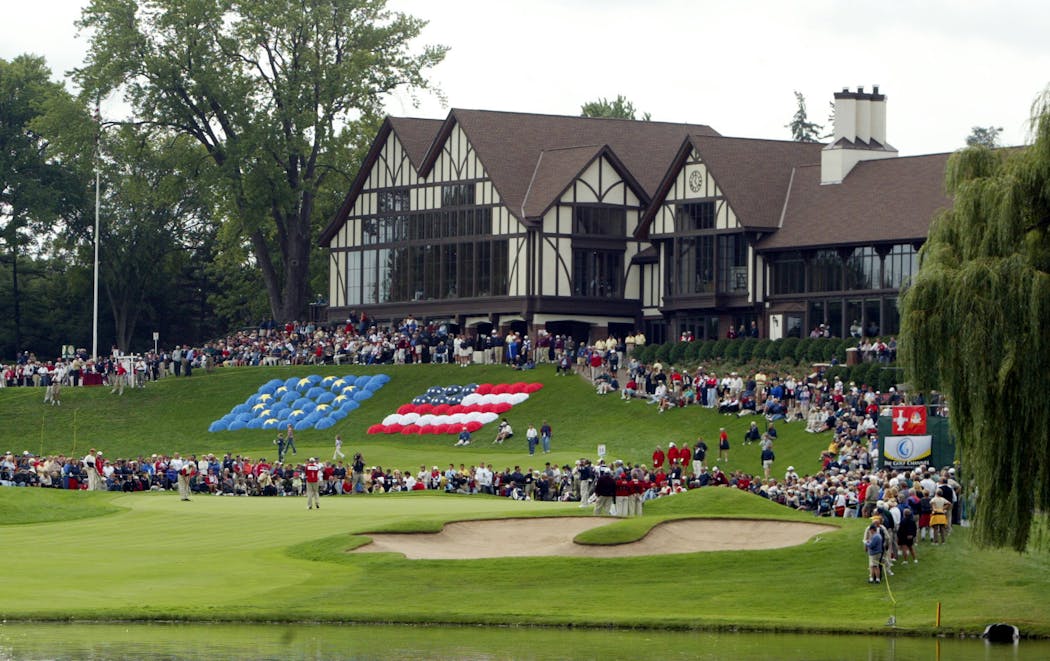In a satchel slung over his shoulder, newly renowned golf course architect Andrew Green carries an iPad downloaded with blueprints, handwritten notes and photographs all a century old.
And some modern necessities as well.
"Rangefinder and sunscreen," Green said, pulling items from his bag. "It's all there, right at my fingertips."
In his head and heart, he also carries something of the spirit of Donald Ross, the prolific "golden age" golf course designer who died in 1948.
The hats Green wears — ''I love my floppys" — protect him from long days working in the sun. Indiana Jones' famous fedora might be more fitting for a restoration specialist who is part Bobcat-operating dirt digger and part archeologist.
Raised in western Virginia and now Maryland-based, Green supervises construction crews and shapes the land himself with skid loader and digital level once or twice a week all summer at private, historic Interlachen Country Club in Edina.
Interlachen is where amateur Bobby Jones won the 1930 U.S. Open on his way to golf's first and only "grand slam" season. He started a little tournament now called the Masters four years later.
It's also where the U.S. Women's Open — last played at Interlachen in 2008 and headed to historic Pebble Beach this week for the first time — returns in 2030.
A major men's championship — possibly a U.S. Open by 2036 — isn't out of the question if Interlachen has the infrastructure and space needed.
Closed to member play in June until next July, the roughly $10 million course restoration will reclaim, rebuild, reshape and/or enlarge all greens, tees and bunkers. Fairways and rough wall to wall will be seeded with new bentgrass varieties more resilient to Minnesota winters.
Interlachen officials hired Green three years ago to bring back a course Ross built a century ago by horse and human, by shovel and push seeder. Green was mostly unknown then to everyone but golf-design geeks, even if he just completed inspired Ross restorations at Oak Hill in upstate New York and Inverness in Ohio — and Congressional's original 1924 design near Washington, D.C., as well.
May's PGA Championship crowned Brooks Koepka, but Green and his loving re-creation of Ross' 1926 Oak Hill East course were the big winners in player and public opinion.
"I wasn't sure what people might say or might think," Green said. "It was certainly beyond my wildest dreams."
Good as gold
Three days after he watched Koepka win at Oak Hill, Green stood at 6:30 a.m. on Interlachen's 12th green, near the highest point on a property he calls "just so spectacular" because of its topography and Ross' hole routing.
Interlachen's founding members in 1909 paid a farmer who lived on the land $12,000 in gold for 146 acres. They traveled by streetcar line and foot in midwinter to seal the deal, then guarded the gold by shotgun overnight until banks opened.
Green stuck a shovel in a green just stripped of its grass and dug down a foot, revealing the course's past layer by layer, from sandy top dressings to thick clay, old pea gravel to its original rich soil.
"The answers are in the dirt," Interlachen head pro Nathan Ollhoff said.
Ross lives on in the dirt to some degree among the 400 courses he originally built in the United States and Canada over nearly 50 years starting in 1900.
Scottish-born, Ross' most famous work also includes his signature Pinehurst No. 2 in North Carolina, East Lake in Atlanta and now particularly Oak Hill. He designed at least five other courses in Minnesota from 1912 to 1927.
At Interlachen, Ross remade all 18 holes of a course built a decade earlier on wooded, rolling farmland 10 miles southwest of Minneapolis. Shovels used then remain stored in maintenance buildings today.
"They have some patina, that's for sure," Interlachen director of golf course and grounds Brian Boll said.
Respecting history
Some features from Ross' original blueprints — including a 262-yard, par-3 17th hole played in the 1930 U.S. Open — have been lost in the mists of time. Others were modified beyond recognition by well-meaning course superintendents and greens-committee members.
They bulldozed Ross' grassy "hummocks" that defined the eighth fairway and shrank greens into egg shapes simply from routine mowing all those years. They also planted trees here, there and everywhere.
Work last winter removed selected trees, which opens sight lines and grows grass better by letting the sunshine through.
When asked how many trees, Green simply says, "The right amount."
"The sole intent of this is to respect Interlachen's history, its heritage," he said.
That history includes Jones' immortal "lily pad" shot that skipped across the pond fronting the ninth green. World Golf Hall of Famer and LPGA founding member Patty Berg learned the game at Interlachen. Walker and Solheim Cups were played there, too.
The new, old course will measure 7,172 yards at par 72, long enough depending how deep the rough is grown. The USGA recently proposed dialing back the golf ball's distance by 15 yards in elite competitions, which could make golden-age courses such as Interlachen more relevant in the modern men's game.
A hill of beans
Whether it was destiny or not, Green spread dried beans his mother used for soup onto the living-room carpet and plowed them with his toy bulldozer when he was 5.
"Black-eyed, kidney," Green said. "I guess it's all dumb luck, but it was better than bringing sand into the house."
He grew up between two orchards, where he worked odd jobs and made apple cider. He learned he loved golf and outdoor work on the local country club's maintenance crew in high school. He studied landscaping and turfgrass at Virginia Tech.
Green then worked construction for years for McDonald & Sons, one of the nation's top course builders, before he started his own company in 2014.
It only took him 15 years to become an overnight sensation, a recent Links magazine profile observed.
Green completed those three plum restoration jobs before Interlachen officials finally reached him by Twitter direct message in July 2020.
"It is both art and science," Interlachen General Manager and CEO Joel Livingood said, "but what these guys do is a lot of art."
After Green received acclaim for his Oak Hill renovation defined by its dramatic bunkering, his phone kept ringing.
Now 45, he has worked only at orchards and golf courses.
"I've been very blessed," he said. "It has been a heck of a ride."
Polishing a jewel
Ross' original plans remain Green's instruction and inspiration after all these years. Green calls the original design "as strong as any Ross course I've visited."
Each shot, each hole "fits and flows" to the next over the land. With every slope Green carefully measures, he aims to stay as true to Ross' original work as possible.
"These are antiques and you don't paint an antique," club historian Brad Sherman said in a video on YouTube that celebrates the restoration. "You polish an antique."
Green considers polishing this Ross original something meant to be. In college, he discovered a newly published collection of Ross' "lost commentaries." In a brief chapter on diagonal bunkers, there is a vintage photo that captivated his imagination because of its bold shapes and angles.
It's the par-5 12th hole at Interlachen.
It was a course unknown to then. It's a hole he now knows so well from his copy of Ross' "Golf Has Never Failed Me."
"There's a certain amount of destiny to it, for some reason," Green said. "I have little post-it notes and arrows in my copy. It's well-loved."
Interlachen's restoration intends to challenge and satisfy first-class players and higher handicappers alike and provide its 400-some member golf families better course conditions.
It's mostly meant to position Interlachen for its next 100 years, just as Ross' original work did the last 100.
"If we're going to do this, we're going to do it only one time and we're going to do it right," Livingood said.

Loons score early, hang on for 2-1 home victory over Sporting Kansas City
Santana homers again as Twins rout Angels 16-5
Marchand breaks team playoff goals mark, Bruins beat Maple Leafs 3-1 to move within win of advancing







